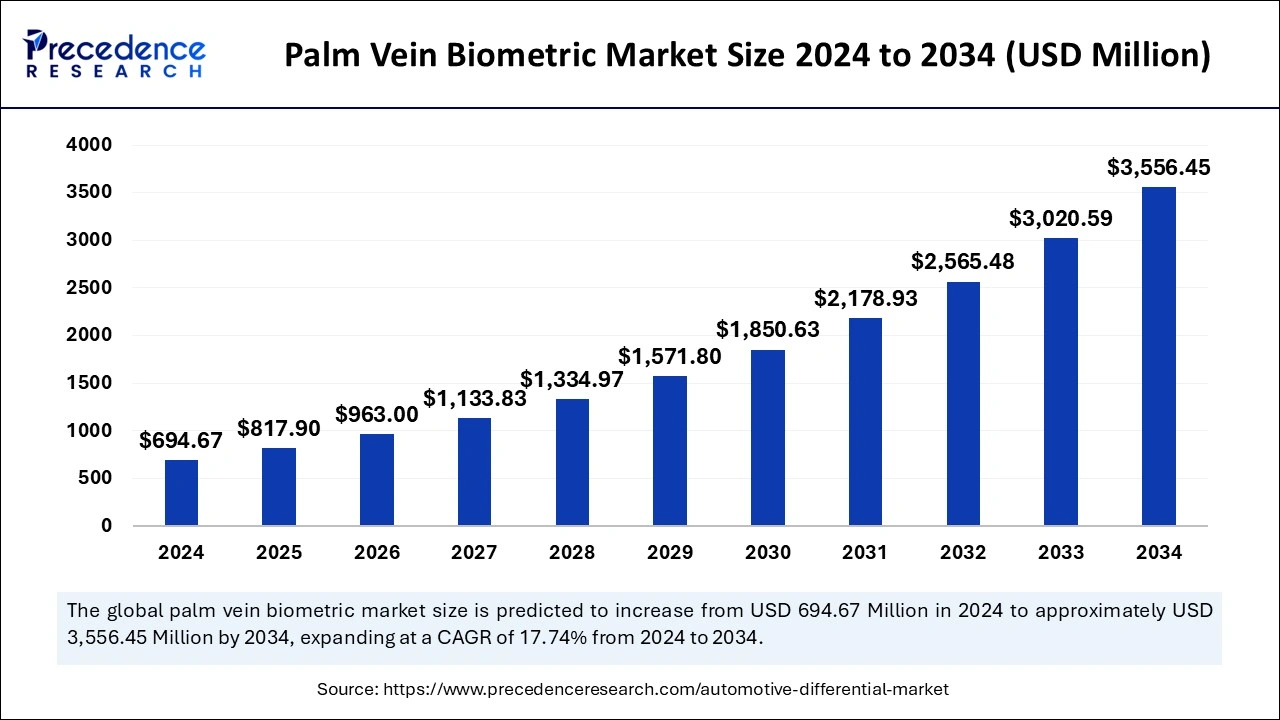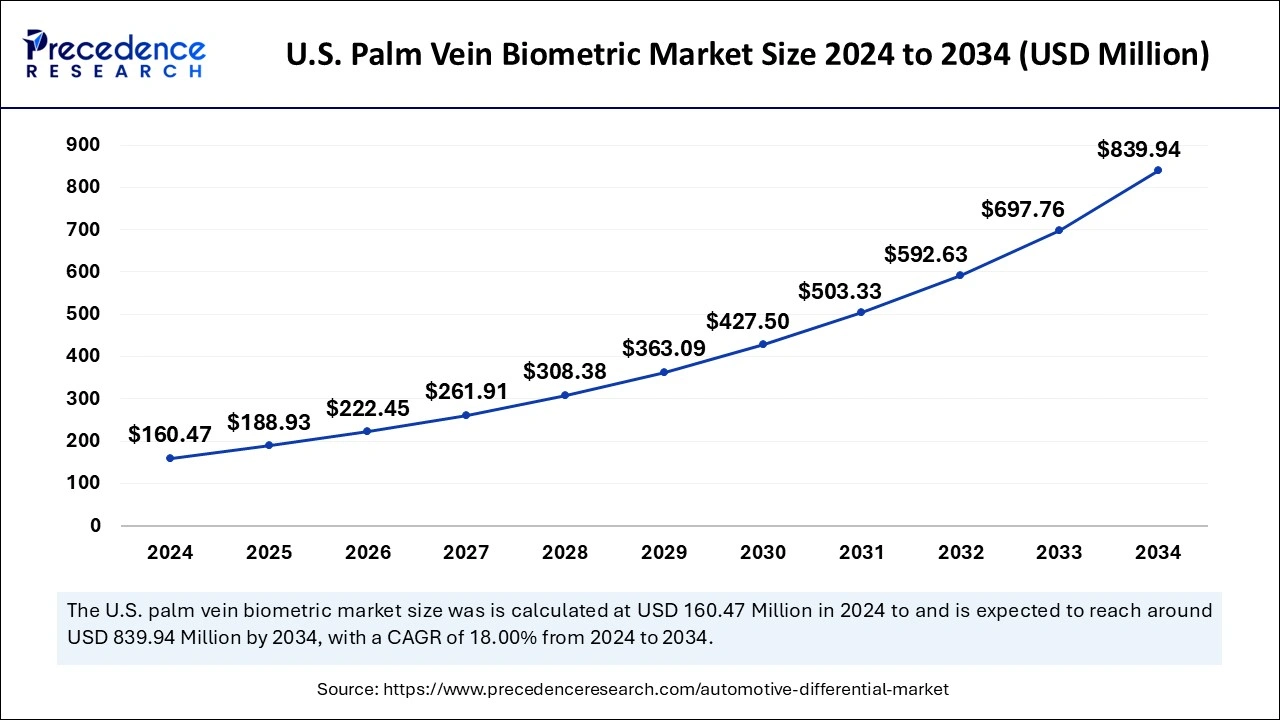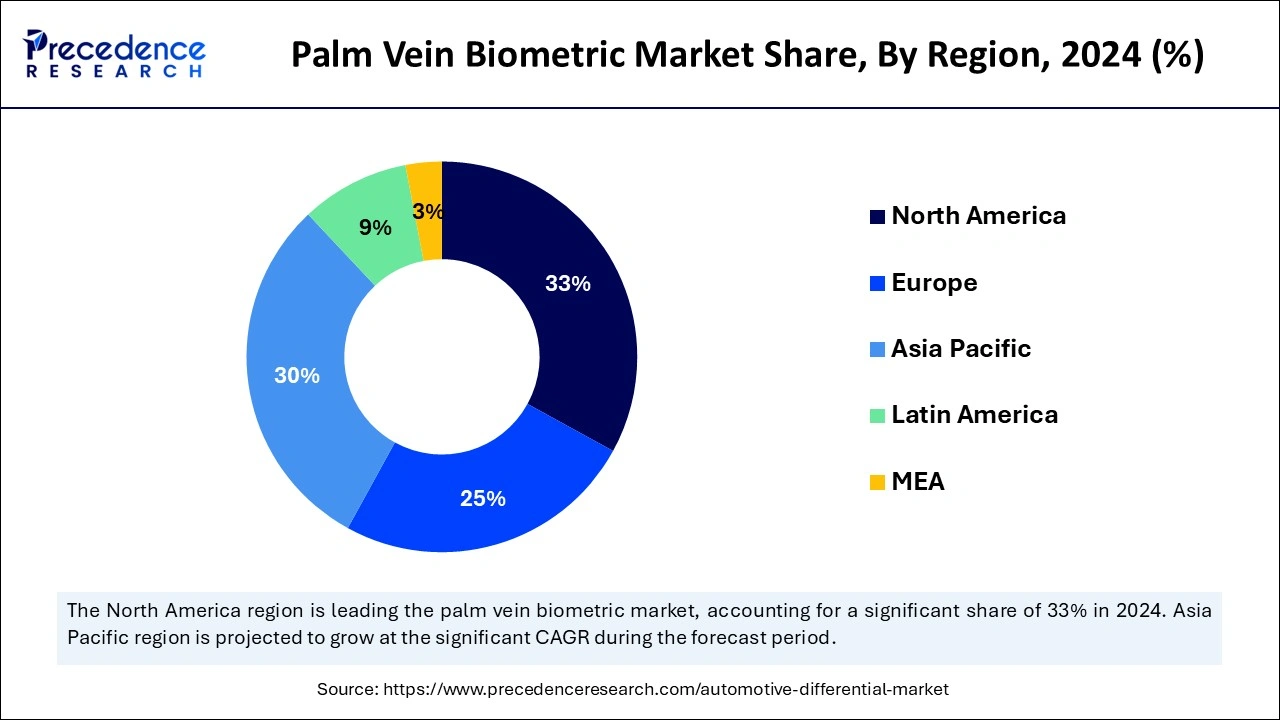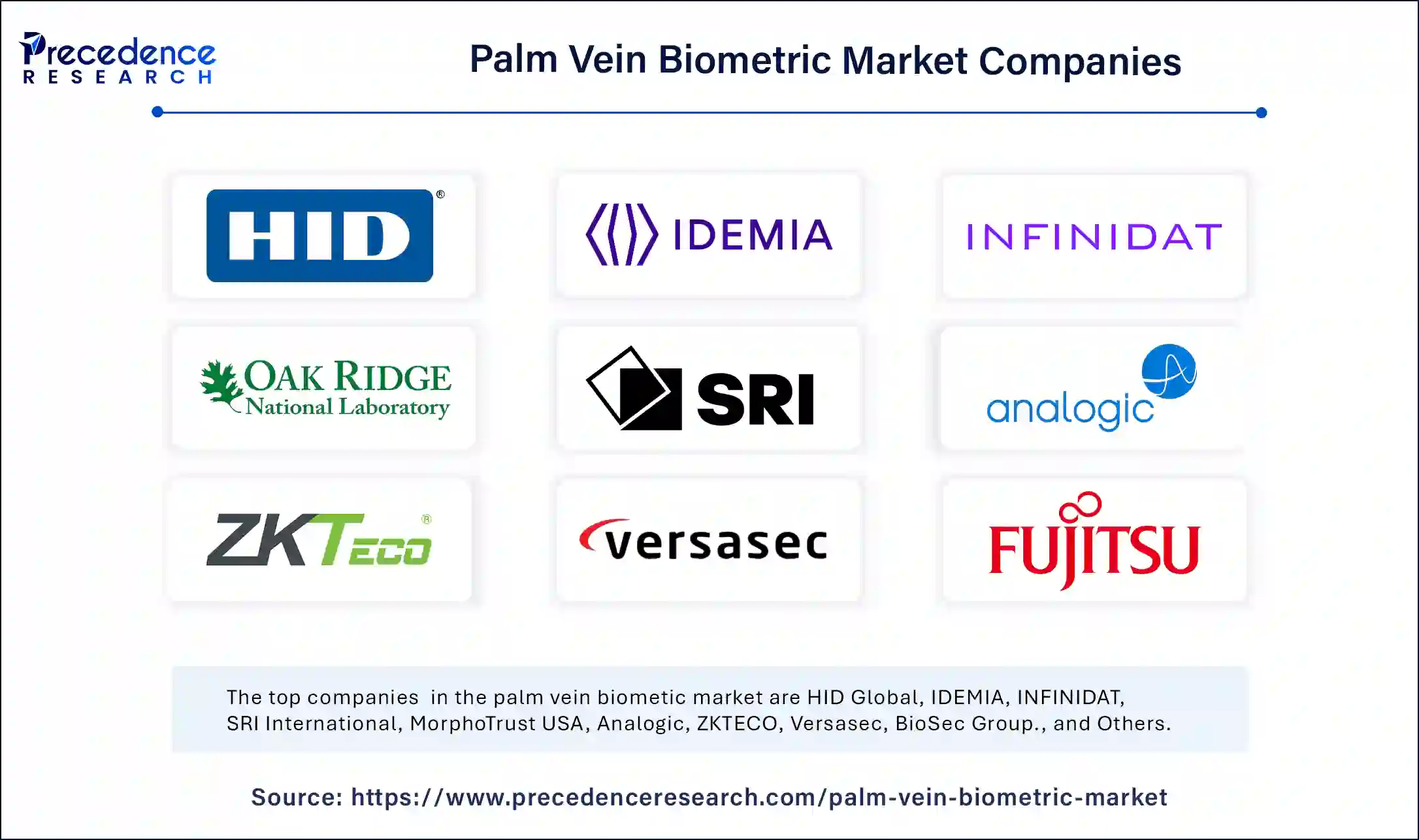September 2024
The global palm vein biometric market size is calculated at USD 817.90 million in 2025 and is forecasted to reach around USD 3,556.45 million by 2034, accelerating at a CAGR of 17.74% from 2025 to 2034. The North America market size surpassed USD 229.24 million in 2024 and is expanding at a CAGR of 17.91% during the forecast period. The market sizing and forecasts are revenue-based (USD Million/Billion), with 2024 as the base year.
The global palm vein biometric market size accounted for USD 694.67 million in 2024 and is expected to exceed around USD 3,556.45 million by 2034, growing at a CAGR of 17.74% from 2025 to 2034. Rising demand for reliable and secure authentication methods across different industries is the key factor driving the palm vein biometric market. Also, increasing instances of security breaches coupled with the escalating business competition across market players can fuel market growth further.

The integration of Artificial Intelligence with palm vein biometric systems for access control and identification of systems is expected to boost the palm vein biometric market, as many institutions and businesses are seeking more reliable and secure biometric solutions. Furthermore, this integration of two cutting-edge technologies can significantly improve their accuracy and efficiency by enhancing the pattern recognition capabilities of the whole system.
The U.S. palm vein biometric market size was exhibited at USD 160.47 million in 2024 and is projected to be worth around USD 839.94 million by 2034, growing at a CAGR of 18.00% from 2025 to 2034.

North America dominated the palm vein biometric market in 2024. The dominance of the region can be attributed to the increasing urbanization along with the innovations in technology, which creates market opportunities for emerging market players. However, high disposable income in developed countries like the U.S. and Canada will impact positive market expansion in the region.

Asia Pacific is expected to show the fastest growth over the studied period. The growth of the region can be credited to the rising awareness of the palm vein biometric market technologies, a growing number of production companies, and the rising population base in emerging nations such as China and India. Furthermore, the increasing adoption of biometrics in commercial and homeland security is expected to fuel market growth in the region shortly.
Palm vein biometrics is a touchless innovative authentication technology that depends on the vascular patterns of the palm as private identification data. It captures an image of the vein pattern under the skin of a person by using IR light and then compares and verifies it with the already existing patterns in the database for authentication. The palm vein biometric market has several benefits, such as higher accuracy, optimum security, and improved reliability.
| Report Coverage | Details |
| Market Size by 2024 | USD 694.67 Million |
| Market Size in 2025 | USD 817.90 Million |
| Market Size in 2034 | USD 3,556.45 Million |
| Market Growth Rate from 2025 to 2034 | CAGR of 17.74% |
| Dominating Region | North America |
| Fastest Growing Region | Asia Pacific |
| Base Year | 2024 |
| Forecast Period | 2025 to 2034 |
| Segments Covered | Technology, Component, Application, End Use, and Regions. |
| Regions Covered | North America, Europe, Asia-Pacific, Latin America, and Middle East & Africa |
Increasing demand for advanced security solutions
Organizations are rapidly seeking advanced methods to improve their security infrastructure from potential cyber threats. This technology gives a significant solution by using g unique vein patterns within the palm, which is quite challenging for traditional biometric systems like facial recognition and fingerprints. In addition, this technology also enhances the overall user convenience and mitigates risks related to unauthorized access.
Limited awareness among end users
The lack of awareness regarding the innovative technology among the palm vein biometric market end users is the major factor hampering its growth. Also, the high implementation and maintenance costs of this technology pose a significant challenge to its market expansion. However, the large reliance of palm vein biometrics on specific environmental conditions, including temperature and lighting, can affect its accuracy and reliability negatively.
Rising awareness of biometric solutions
There is an increasing awareness of this solution among many demographics, such as governments, businesses, and consumers. Because stakeholders become more aware of the advantages of the palm vein biometric market technology. Furthermore, governments across the globe are realising the need for secure identification systems.
The contact-based segment dominated the palm vein biometric market in 2024. The dominance of the segment can be attributed to the increasing need for advanced accuracy in identification, which makes it important for environments where security is essential. However, obstacles like data privacy concerns and requirements for strong regulatory frameworks can hamper market growth.
The contactless segment is expected to grow at the fastest rate over the forecast period. The growth of the segment can be credited to the rapid processing times and convenience provided by this technology, which makes it crucial for high-traffic areas, including public transportation and airports. The segment's significance is highlighted by its adaptability specific to diverse needs.
The hardware segment dominated the palm vein biometrics palm vein biometric market in 2024 and is expected to grow at the fastest rate over the forecast period. The dominance and growth of the segment can be credited to the rising development of advanced hardware materials to grow the overall efficiency of the biometric system. The hardware segment includes scanners, cameras, and readers. These hardware components enhance the efficiency of the system.
The healthcare segment dominated the palm vein biometric market in 2024 and is expected to grow at the fastest rate over the forecast period. The dominance and growth of the segment can be linked to the increasing use of this technology to improve patient identification and ensure proper access to datasets. In addition, it also helps track and monitor individual patient history based on the data provided to the system.
The commercial segment dominated the palm vein biometric market in 2024. The dominance of the segment can be driven by the increasing adoption of advanced security solutions from businesses to safeguard confidential data and prevent unauthorized access. However, increasing business competition among end-use industries has raised the demand for the protection of confidential information of an organization.
The residential segment is anticipated to grow at the fastest rate over the projected period. The growth of the segment is owing to the increasing use of smart home technologies consisting of biometric systems for improved security and convenience. Also, various government initiatives are enabling the higher adoption of this technology for residential use.

By Technology
By Component
By Application
By End Use
By Geography
For inquiries regarding discounts, bulk purchases, or customization requests, please contact us at sales@precedenceresearch.com
No cookie-cutter, only authentic analysis – take the 1st step to become a Precedence Research client
September 2024
November 2024